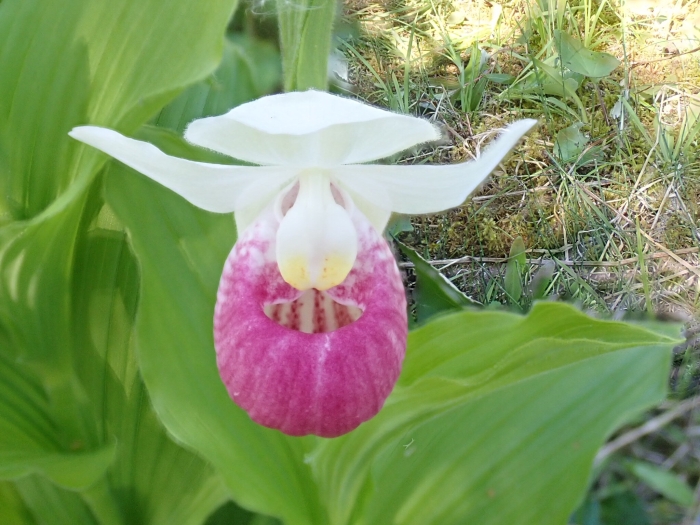Showy Lady’s Slipper
(Cypripedium reginae)
Showy Lady’s Slipper (Cypripedium reginae)
/
/

John Brew
CC BY 4.0
Image By:
John Brew
Recorded By:
Copyright:
CC BY 4.0
Copyright Notice:
Photo by: John Brew | License Type: CC BY 4.0 | License URL: http://creativecommons.org/licenses/by/4.0/ | Rights Holder: John Brew | Publisher: iNaturalist | Date Created: 2018-07-13T07:28:56Z |















































Estimated Native Range
Summary
Cypripedium reginae, commonly known as Showy Lady’s Slipper, is a deciduous perennial herb that thrives in the cool, moist environments of northern bogs, wetlands, and damp woodlands in the Northeastern USA and Eastern Canada. This orchid is distinguished by its striking flowers, which feature a distinctive pouch-shaped labellum, reminiscent of a slipper. The Showy Lady’s Slipper can reach a height of 21–100 cm (0.7–3 ft) and often produces multiple stems from a single rootstock. Each stem bears three to five alternate, pubescent leaves, and one to three large, showy flowers. The blooms are characterized by white upper petals and a rose-pink to magenta pouch, which can be 2.5–5.5 cm (0.98–2.17 in) long. The flowering season typically occurs in late spring to early summer.
In cultivation, the Showy Lady’s Slipper is valued for its ornamental flowers and is often used in shade gardens and naturalized woodland settings. It requires consistent moisture and well-drained soils rich in organic matter. While it can tolerate full sun, partial shade is preferred to prevent the bleaching of the labellum and to maintain the vibrancy of the flower color. Due to its specific growing requirements and slow propagation from seed, it is considered a challenging plant for gardeners. This species is also known for its long-term survival once established, making it a rewarding choice for patient cultivators. However, gardeners should be aware of its vulnerability to root rot if overwatered and its sensitivity to transplanting.CC BY-SA 4.0
In cultivation, the Showy Lady’s Slipper is valued for its ornamental flowers and is often used in shade gardens and naturalized woodland settings. It requires consistent moisture and well-drained soils rich in organic matter. While it can tolerate full sun, partial shade is preferred to prevent the bleaching of the labellum and to maintain the vibrancy of the flower color. Due to its specific growing requirements and slow propagation from seed, it is considered a challenging plant for gardeners. This species is also known for its long-term survival once established, making it a rewarding choice for patient cultivators. However, gardeners should be aware of its vulnerability to root rot if overwatered and its sensitivity to transplanting.CC BY-SA 4.0
Plant Description
- Plant Type: Herb
- Height: 2-3 feet
- Width: 1-1.5 feet
- Growth Rate: Slow
- Flower Color: Pink, White
- Flowering Season: Summer
- Leaf Retention: Deciduous
Growth Requirements
- Sun: Part Shade
- Water: Medium
- Drainage: Medium
Common Uses
Bee Garden, Deer Resistant, Showy Flowers, Water Garden
Natural Habitat
Cool, moist environments of northern bogs, wetlands, and damp woodlands in the Northeastern USA and Eastern Canada
Other Names
Common Names: Queen Lady’s-Slipper, Pink-And-White Lady’s-Slipper, Showy Lady’s-Slipper, Cypripède Royal, Cypripède De La Reine, Drottningsko
Scientific Names: , Cypripedium reginae, Cypripedium reginae f. albolabium, Cypripedium spectabile, Cypripedium album, Cypripedium reginae f. reginae, Cypripedium reginae var. album, Calceolus reginae, Cypripedium canadense, Cypripedium hirsutum f. album
GBIF Accepted Name: Cypripedium reginae Walter